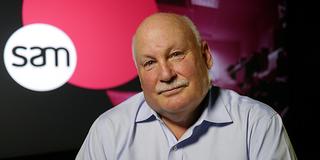Q&A: Tim Thorsteinson on Industry Trends
AMSTERDAM, THE NETHERLANDS—Earlier this year, industry veteran Tim Thorsteinson was tapped to oversee the merger of Snell and Quantel. At the IBC Show last month, the company was rebranded “SAM,” an acronym for Snell Advanced Media. TV Technology Editor-in-Chief Tom Butts sat down with Tim at the show to discuss the company’s legacy and its future in the broadcast/media production marketplace.

TVT: Why SAM?
TIM: We went through a fairly logical process relative to the rebranding. We looked at the two brands and the brand equity they had in the marketplace and where we thought we were going in the future and decided that ultimately we didn’t want to divorce ourselves from both brands because of the cost—both financial and psychically. Disconnecting wasn’t something we wanted to do. Of the two brands, Quantel is stronger in post-production and editing and Snell’s stronger in playout and some of those areas, so we decided to keep the Snell brand and carry it forward. We’ve really positioned the company away from traditional broadcast and more towards advanced media.
TVT: How are your customers reacting?
TIM: I think the Quantel customers want to see a product roadmap going forward and how we’re going to transition their media into the OTT world and we have a good story there. We’ve been actually delivering it to them over the last several months. We’ll probably use the Quantel brand in that workflow area fairly extensively.
TVT: Are you changing any product names?
TIM: We’re not changing any product names but Quantel post production products will be rebranded Qantel Rio. On the broadcast side, Enterprise sQ is still the workflow system we sell. [Renaming a product] generally doesn’t change the technology of the product roadmap which is what our customers were primarily interested in. We have a significant installed base, particularly in playout with Morpheus. We’ve hired 27 new engineers and we’ll be hiring more. A name change is a name change, but what customers want to know is ‘what’s your road map.’ We’re one organization now. When I joined in March it was literally two separate companies—two separate sales companies, two separate support and engineering organizations—now they’ve all been combined. So we have one engineering team, one support team, one sales force. Where we were Quantel or Snell before, we’re all SAM.
Get the TV Tech Newsletter
The professional video industry's #1 source for news, trends and product and tech information. Sign up below.
TVT: How has the rebranding and merger affected the company’s culture?
TIM: Cultures take a long time to change. We’re making good inroads in improving the culture but it’s hard work and takes a long time. From my perspective, the culture used to be pretty high-end, pretty inwardly focused, pretty expensive. Our goal is to be quicker to market and do a better job of listening to the market, to be more open. Take storage for example. We’re not a storage supplier so we need to develop software to work with more standards-based storage. Things like Adobe Plug-ins, obviously Adobe’s got a great following. We need to play in that ecosystem, not try to fight it.
TVT: How important is software development to SAM now?
TIM: We’re much more a software company today than we have ever been in the past. A significant amount of our revenue comes from customer support and software systems. If you look at Morpheus and ICE, it’s primarily software and ultimately it will be entirely software someday. The interesting thing for all of us—the ‘A’ companies and us—is how do you remain relevant in the editing world today. And from my perspective it’s more about the management of the content and the flow of it, than it is about the actual editing. We want to be open from an editing perspective. We’ll sell our own editing products, but interrelating to an Apple or an Adobe is an imperative of the marketplace. We’re making a big play on asset management; we bought this big company in Rome called Mantrics, and we will do more in that space as we move forward because our big installed base of Quantel News and Sports customers want to open up their systems and use Adobe plug-ins.

TVT: Are you comfortable with the company’s market presence in the U.S.?
TIM: No. A year from now we’ll be more of a global player than we are today. We’ve made an investment in the U.S., Latin America, and Middle East. Snell today is very strong with a small number of customers. We do a lot of our business with a few customers and the goal is to broaden that a bit and compete with the logical players in that space.
TVT: What’s your take on the industry’s transition to IP? How has this affected the company’s bottom line?
TIM: It’s an interesting time. IP kind of levels the playing field and opens up the procurement process to a situation where people are looking at other alternatives today. Business has been good lately, but earlier this year it was a “perfect storm” of negative situations. First there is the transition to IP, then the business model of the end users is changing dramatically.
When I was at other companies, my thought was that the U.S. and Europe markets are mature so they’re going to be relatively low or slow growth and Russia, China, India, Latin America, the Middle East are going to provide growth. But those all shut off. None of us did anything in Russia in the last year and when I was at other companies, we were building a fairly significant business in Russia. China has had its issues economically in the past year. India has had a huge devaluation in its currency, and Brazil has had currency problems. So all those areas that provided the 5-10 percent growth shut off. Between that and the IP transition, it caused people to take pause. But we’re going to be up 5-10 percent for the third quarter over last. For us, business is better—certainly not where we’d like it to be—but better.
TVT: What’s your assessment of the U.S. broadcast market?
TIM: The U.S. market has consolidated and the TV station market is problematic. They now have a “Blackmagic budget,” not an “Evertz” or “Snell” budget. If they can get something for $5,000 that kinda works, great, that’s where their budget is. And I get that. And that’s a big change in the market. If you go back 10 years ago, all those TV stations were investing. I remember selling a $300,000 high-end production switcher in Boston for news. Then everyone in the market needed it. So I sold 4-5 Kalypsos in Boston. That wouldn’t happen today.
On the other hand, the non-traditional media customers—the Amazons and Netflixes and Hulus—they are buying some so that’s a good thing. But certainly the market is smaller than it was.
I think the broadcast market in the U.S. is challenged. For example, for us, in editing, we have a couple hundred-million-pound installed base and I need to figure out how I’m going to be relevant in the market. The TV stations need to figure out what their relevance is. What is their value?
Luckily for us we’re relatively small so if I can figure out how to direct my 200 engineers towards where the customers are going I can have a survivable business model. But it’s a dramatically different world.
Where do broadcast technology vendors fit in? That’s why we’re “advanced media.” We need to figure out where to play in that world. I’ve been in the industry for 20-25 years and this is a time of greatest change. There’s nothing like this.
TVT: Why? Hasn’t our industry always been in a state of transition?
TIM: Yes, but this is much different. In the past, they were more linear progressions. When I got to Grass in 1996, everyone was transitioning from analog to digital, then everyone was going to HD, but those were progressions. This is different. In all those cases, the business model of the customer wasn’t really changing. They were still selling ads and their business model wasn’t any different.
Today, the big difference from my perspective is, they [the customer] don’t really know what their business model is, which drives the desire on their part for flexibility. In our first quarter, we had a broadcaster in Malaysia who spent $5 million upgrading to HD for a fixed plant. But there aren’t many of those. A network is not going to do that today because they’re not sure what the returns are going to be. They would love to be able to just run it all with software on some standard platforms, and someday they will be able to. But people have been asking for that forever.
Eventually the technology will get there. And we’ll all be supplying it, but there will be a huge shakeup. You take the Beldens and the Imagines and the Evertzs and EVSs and Avids; five years from now, they will not exist in their current form because what they’re selling today won’t be being purchased. Once routers go IP and it’s all a Cisco switch, there’s about a $200-300 million hardware business today that we’re all making good money on that’s not going to be there.
TVT: Are you dropping any product lines?
TIM: No, but we’re funneling R&D dollars to where we think the future is going to be. There’s only so many new multiviewer boards you can afford to invest in because there’s already seven on the market and they all work, but five years from now...
TVT: Is there more competition now?
TIM: Yes, for the new technology. The competition is rough.
TVT: What about all the new players like Netflix and Amazon?
TIM: There’s a few large ones, but there’s not like a hundred that we can go sell to.
TVT: What’s your vision for our industry’s future? And for SAM?
TIM: I was looking at a customer demo the other day, where on a timeline, we were able to identify graphically, which content could be used and which couldn’t. There was a part that was green where the customer owned the rights to, there was a part that was yellow which needed to be checked out and red, which couldn’t. Those kind of content management tools are the future, not the editing.
Adobe has a great product for $50 a month, who is going to beat that? So we have to interoperate in that environment. I was in a business once in my career at Tektronix called “network computers.” It was basically a dumb terminal and all the value was in the core. Oracle brought out a product called Multi-user NT and my business was eliminated overnight. My value disappeared and I ended up exiting it for pennies on the dollar than what it was originally worth. That’s the fear. That all of a sudden you wake up one day and you’re not relevant. The good news is we’re small. The smaller nimble companies are going to do well.
Tom has covered the broadcast technology market for the past 25 years, including three years handling member communications for the National Association of Broadcasters followed by a year as editor of Video Technology News and DTV Business executive newsletters for Phillips Publishing. In 1999 he launched digitalbroadcasting.com for internet B2B portal Verticalnet. He is also a charter member of the CTA's Academy of Digital TV Pioneers. Since 2001, he has been editor-in-chief of TV Tech (www.tvtech.com), the leading source of news and information on broadcast and related media technology and is a frequent contributor and moderator to the brand’s Tech Leadership events.

